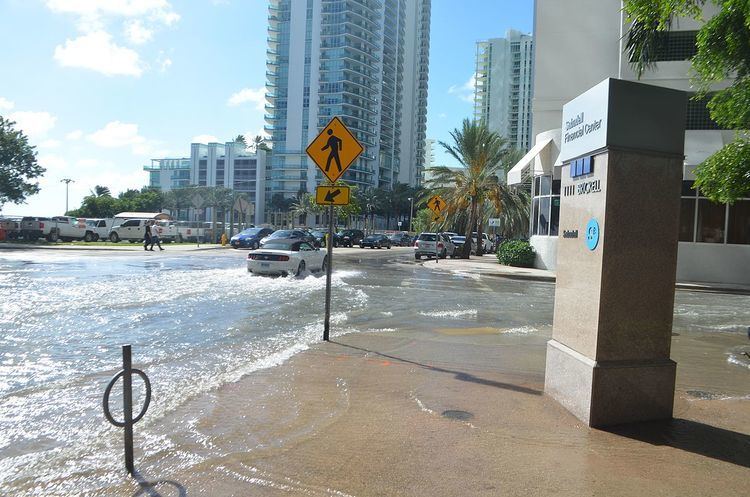 | ||
Tidal flooding, also known as sunny day flooding or nuisance flooding, is the temporary inundation of low-lying areas, especially streets, during exceptionally high tide events, such as at full and new moons. The highest tides of the year may be known as the king tide, with the month varying by location. In Florida, controversy was created when state-level government mandated that the term "nuisance flooding" and other terms be used in place of terms such as sea level rise, climate change and global warming, prompting allegations of climate change denial, specifically against Governor Rick Scott. This amid Florida, specifically South Florida and the Miami metropolitan area being one of the most at risk area in the world for the potential effects of sea level rise, and where the frequency and severity of tidal flooding events increased in the 21st century. The issue is more bipartisan in South Florida, particularly in places like Miami Beach, where a several hundred million dollar project is underway to install more than 50 pumps and physically raise roads to combat the flooding, mainly along the west side of South Beach, formerly a mangrove wetland where the average elevation is less than one meter (3.3 feet). In the Miami area, where the vast majority of the land is below 10 feet (3.0 m), even a one-foot increase over the average high tide can cause widespread flooding. The 2015 and 2016 king tide event levels reached about 4 feet (1.2 m) MLLW, 3 feet (0.9 m) above mean sea level, or about 2 feet (0.61 m) NAVD88, and nearly the same above MHHW. While the tide range is very small in Miami, averaging about 2 feet (0.61 m), with the greatest range being less than 2 metres (6.6 ft), the area is very acute to minute differences down to single inches due to the vast area low elevation. NOAA tide gauge data for most stations shows current water level graphs relative to a fixed datum, as well as mean sea level trends for some stations. During the king tides, the local Miami area tide gauge at Virginia Key shows levels running at times 1 foot (0.30 m) or more over datum.
Tidal flooding is capable of majorly inhibiting natural gravity-based drainage systems in low-lying areas when it reaches levels that are below visible inundation of the surface, but which are high enough to incapacitate the lower drainage or sewer system. Thus, even normal rainfall or storm surge events can cause greatly amplified flooding effects. One passive solution to intrusion through drainage systems are one way back-flow valves in drainage ways. However, while this may prevent a majority of the tidal intrusion, it also inhibits drainage during exceptionally high tides that shut the valves.
History
Due to changing geography such as subsidence, and poorly planned development, tidal flooding may exist separate from modern nuisance flooding associated with sea level rise and anthropocentric climate change. The widely publicized Holland Island in Maryland for example has disappeared over the years mainly due to subsidence and coastal erosion. In the New Orleans area on the Gulf Coast of Louisiana, land subsidence results in the Grand Isle tide gauge showing an extreme upward sea level trend.
